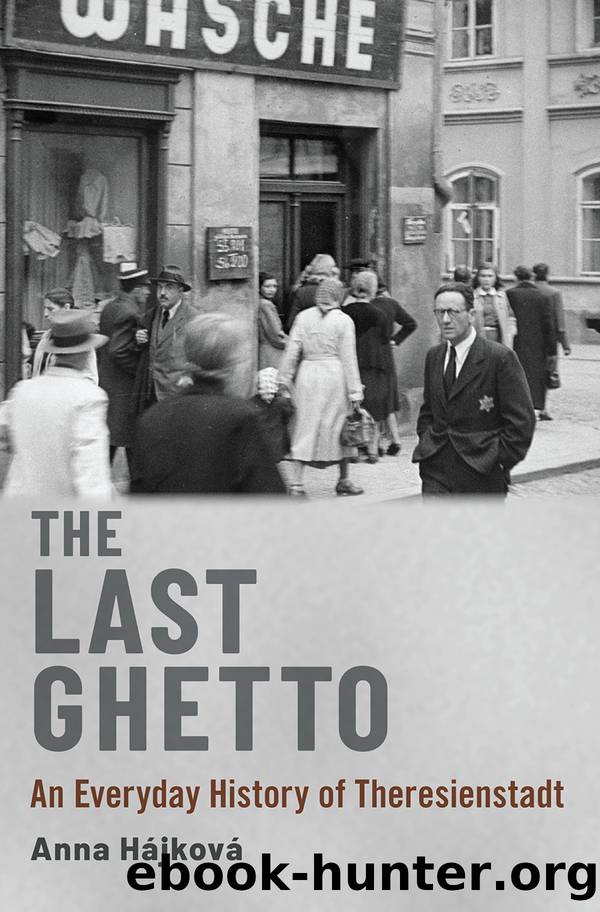The Last Ghetto by Anna Hájková

Author:Anna Hájková
Language: eng
Format: epub
Publisher: Oxford University Press
Published: 2020-08-15T00:00:00+00:00
The drawing shows a young woman from Agriculture harvesting wheat. Agricultural manual labor was a familiar theme for young Zionists, many of whom had attended a hachshara, Zionist agricultural training. However, the scene in this picture is situated in the ghetto; the mountain in the background has a sunset with the Star of David and the label âTerezÃn.â Similar to the aesthetics that Lotka BureÅ¡ová employed in her drawing of a young woman jumping through a frame, the features and attire of the peasant girl are markedly non-Jewish: she has blonde hair and red cheeks and is dressed in white, red, and blueâtraditional Czech colors. The attire mirrors the clothes worn by Czech rural workers. Finally, the mountain in the background, even though it has two peaks, is redolent of Mount ÅÃp. That mountain, a symbol of Czech statehood, is eleven miles away from TerezÃn and visible from the town walls. The birthday album ends with the wish that everyone may soon go wherever they desire.
Ornstein kept the album in her papers, which supported the Zionist master narrative of TerezÃn that she helped create.126 Key elements of âCzechnessâ are implicit in the work. For instance, the cuteness of the figure is expressed in a way that appeals to the viewerâs emotions. Unlike Zionists in Palestine, Zionists in TerezÃn did not have their own established visual aesthetics; they often used Czech aesthetics to express emotional messages. As in BureÅ¡ováâs drawing, the fact that the figure is female is significant; symbols of emotional national belonging are often represented as female.
The prisoner society closely observed the ethnicity of women in public roles, and cultural productions were a particularly public role. When inmates criticized Josefa Klinkeová for her lack of Czechness, the critique addressed her lack of womanliness. When Marion Podolier was accepted as MaÅenka in The Bartered Bride, narrators stressed her loveliness, the beauty of her voice, and her ability to integrate linguistically, thereby linking her appropriate femininity to her ethnic inclusion as Czech. All the major male singers were Czech, but they were not scrutinized as the women were. No one singled out Alexandr Singer for his Carpathorussian roots or Rafael Schächter for his Romanian background.
Nor were male performers criticized for their ambition. The two women directors, Vlasta Schönová and Irena Dodalová, by contrast, were attacked for being outspoken and assertive. These same qualities were praised in male colleagues, including Norbert Fried and Karel Reiner. Criticisms of Schönová and Dodalová did not necessarily address their directorial skills. Dodalová, who shot the first TerezÃn propaganda film in 1942, was disparaged for âcollaboration.â127 Schönová was condemned for her sexual conduct because of her relationship with Benjamin Murmelstein. Many other women had relationships with unpopular functionaries, but people spread rumors about Schönová because in TerezÃn, the norms of female behavior were defined more conservatively, especially when in combination with power and ambition.
In order to become an active performer in TerezÃn, musicians, especially those who played an instrument, needed ambition. People had to put themselves forward to secure access to instruments and time to rehearse.
Download
This site does not store any files on its server. We only index and link to content provided by other sites. Please contact the content providers to delete copyright contents if any and email us, we'll remove relevant links or contents immediately.
| Africa | Americas |
| Arctic & Antarctica | Asia |
| Australia & Oceania | Europe |
| Middle East | Russia |
| United States | World |
| Ancient Civilizations | Military |
| Historical Study & Educational Resources |
Magic and Divination in Early Islam by Emilie Savage-Smith;(1498)
Ambition and Desire: The Dangerous Life of Josephine Bonaparte by Kate Williams(1342)
Bohemians, Bootleggers, Flappers, and Swells: The Best of Early Vanity Fair by Bohemians Bootleggers Flappers & Swells- The Best of Early Vanity Fair (epub)(1341)
Papillon by Henry Charrière(1306)
Twelve Caesars by Mary Beard(1253)
Operation Vengeance: The Astonishing Aerial Ambush That Changed World War II by Dan Hampton(1134)
What Really Happened: The Death of Hitler by Robert J. Hutchinson(1126)
London in the Twentieth Century by Jerry White(1110)
Time of the Magicians by Wolfram Eilenberger(1085)
Twilight of the Gods by Ian W. Toll(1083)
The Japanese by Christopher Harding(1081)
Lenin: A Biography by Robert Service(1041)
The Devil You Know by Charles M. Blow(983)
A Social History of the Media by Peter Burke & Peter Burke(936)
Freemasons for Dummies by Hodapp Christopher;(921)
Napolean Hill Collection by Napoleon Hill(901)
Henry III by David Carpenter;(890)
The Churchill Complex by Ian Buruma(879)
The Rise and Triumph of the Modern Self by Unknown(877)
